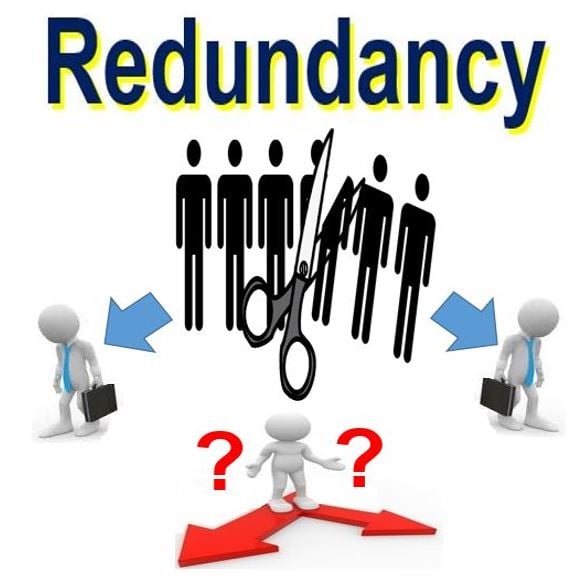If a Company Goes Bust Who Pays Redundancy? Lawful Insights for UK Employees
If a Company Goes Bust Who Pays Redundancy? Lawful Insights for UK Employees
Blog Article
Investigating the Interaction Between Firm Redundancy and Organizational Flexibility for Future Development
In the vibrant landscape of today's business world, the elaborate relationship in between business redundancy and organizational adaptability emerges as an essential variable for continual growth and success. Firms usually encounter the difficulty of striking a delicate balance in between maintaining a level of redundancy to alleviate threats and cultivating flexibility to react promptly to the ever-evolving market needs. This delicate interplay holds the essential to not just surviving in stormy times however additionally prospering in the face of unpredictability. As we discover the complex dimensions of this interaction, appealing insights right into just how organizations browse these intricacies to pave the way for future growth wait for.
Relevance of Firm Redundancy
Business redundancy is a crucial component that improves organizational resilience and alleviates operational risks. By including redundancy procedures within the business framework, companies can better hold up against unexpected disturbances and fluctuations in business environment. Redundancy works as a strategic buffer, permitting business to adapt and respond efficiently to unanticipated challenges without endangering essential procedures.
One key aspect of the significance of business redundancy is its role in making sure continuity throughout times of dilemma. When encountered with abrupt modifications or emergencies, repetitive systems, resources, or employees can action in to preserve important features and stop extensive disturbances. This connection not only safeguards the company's track record and client trust however likewise reduces financial losses and operational downtime.

Approaches for Business Versatility

Creating adaptable organizational frameworks that allow for quick modifications to market dynamics and consumer demands is important for staying affordable in a rapidly developing environment. By proactively identifying possible disturbances and opportunities, organizations can proactively grow and adapt in an ever-changing organization landscape.
Balancing Redundancy and Versatility
Attaining a harmonious stability in between operational redundancy and organizational flexibility is vital in browsing the intricacies of a dynamic organization environment. Redundancy within a company provides a safety internet, guaranteeing connection and look these up stability in operations. However, an unwanted of redundancy can result in inefficiencies and prevent adaptability to changing market conditions. On the other hand, business flexibility permits companies to react immediately to outside disruptions and seize brand-new possibilities. Striking the best balance between redundancy and flexibility is a fragile procedure that calls for a deep understanding of the organization's goals, industry dynamics, and threat tolerance.
To accomplish this equilibrium, firms need to perform routine evaluations of their operations to identify locations where redundancy is needed for danger reduction and where versatility can drive development and growth. Carrying out adaptable frameworks, promoting a culture of constant knowing and improvement, and urging open communication across all levels of the organization are crucial techniques to integrate redundancy and flexibility efficiently. By lining up these two vital components, companies can place themselves for sustainable growth and success in an ever-changing service landscape.
Study on Adjustment Success
In analyzing instances of effective business adaptation, it becomes apparent that the interplay in between functional redundancy and adaptability is a specifying aspect in shaping durable organizations. A DVD rental service, Netflix demonstrated amazing flexibility by transitioning into a streaming system when digitalization disrupted the sector. These case researches highlight the relevance of More about the author functional redundancy combined with business versatility in promoting long-lasting development and competitiveness.
Building Strength for Future Growth
Structure durability for future development calls for a strategic placement of operational procedures with market characteristics and arising patterns. Companies should adjust to transforming environments by promoting a culture of adaptability, innovation, and continuous renovation.
In addition, cultivating strong partnerships with stakeholders, such as customers, workers, vendors, and the area, is necessary for keeping and weathering unpredictabilities count on and assistance during unstable times. Efficient communication and openness play an important duty in building resilience, as they aid facilitate and align assumptions partnership in browsing unpredictabilities.
Additionally, companies need to prioritize learning and development campaigns to upskill employees click for more info and outfit them with the required devices to adjust to changing conditions. By purchasing their workforce, business can improve their versatility and dexterity, ultimately enhancing their resilience for sustainable future development.
Verdict

In the vibrant landscape of today's business world, the intricate relationship between firm redundancy and business flexibility emerges as a vital variable for sustained development and success. Business commonly deal with the difficulty of striking a delicate balance in between keeping a level of redundancy to mitigate threats and promoting adaptability to react swiftly to the ever-evolving market needs.To accomplish this balance, firms need to carry out normal analyses of their procedures to identify locations where redundancy is necessary for threat reduction and where versatility can drive innovation and development.In verdict, the interplay in between firm redundancy and organizational versatility is vital for future development. Building resilience through a mix of redundancy and versatility will certainly ensure that firms are prepared for the challenges of the future.
Report this page